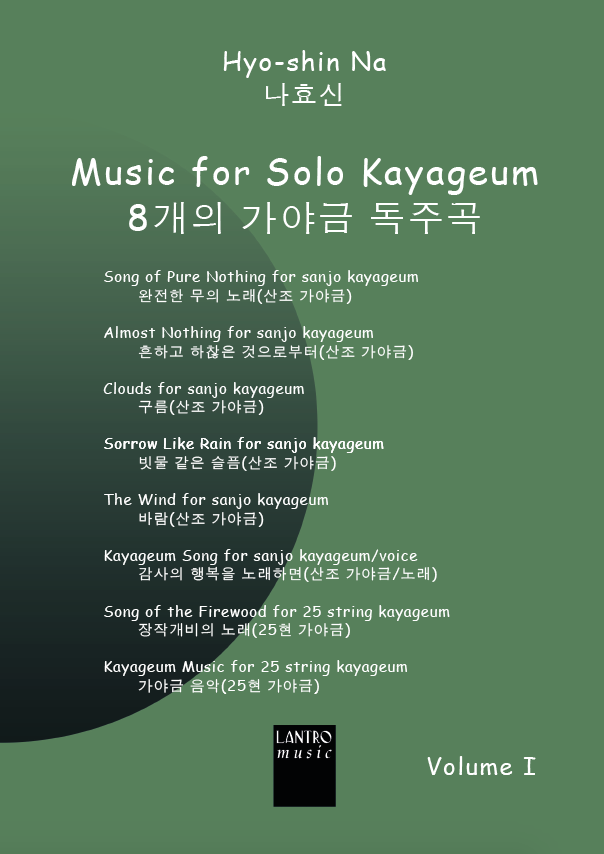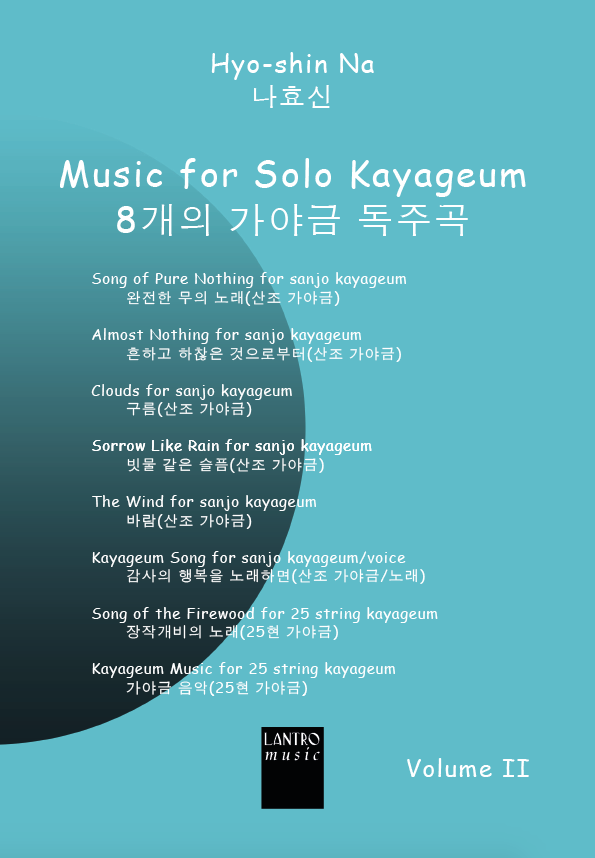

HYO-SHIN NA’s Music for Solo Kayageum
– Volume I –
Song of Pure Nothing for sanjo kayageum (2019)
Almost Nothing for sanjo kayageum (2019)
Clouds for sanjo kayageum (2020)
Sorrow Like Rain for sanjo kayageum (2020)
– Volume II –
The Wind for sanjo kayageum (2020)
Kayageum Song for sanjo kayageum/voice (2009)
Song of the Firewood for 25 string kayageum (2010)
Kayageum Music for 25 string kayageum (2016)
Many of Hyo-shin Na’s solo kayageum pieces have their origin in literary texts. Ezra Pound’s “The Lament of the Frontier Guard” (a translation from the Chinese poet Li Po) was the start of Sorrow Like Rain:
. . . Bones white with a thousand frosts.
High heaps covered with trees and grass;
Who brought this to pass?
and
Ah, how shall you know the dreary sorrow at the North Gate,
With Rihaku’s name forgotten,
And we guardsmen fed to the tigers.
Song of Pure Nothing comes from the poem by Guillaume de Poitiers (the beginning, translated here by W. S. Merwin):
I’ll make a song of pure nothing,
not about me or another being,
not about love or being young
or anything.
it came to me while I was sleeping
on my horse riding.
Almost Nothing began when Na read a comment by the Polish painter Jozef Czapski: “Each time it is almost nothing. But that ‘almost nothing’ signifies everything.”
The title and inspiration for Song of the Firewood came from a short poem by Jaime de Angulo, who lived mostly in California as a linguist, musicologist and poet:
I am old, twisted, dry. I am cold.
Build the fire.
Heh! Heeh-heh … he-he-he … feel good.
Let the chief call the dancers.
The title and inspiration of Clouds came from a poem by Wisława Szymborska.
Kayageum Music presents simple materials in a variety of ways, without developing them.
In Kayageum Song, the words sung by the kayageum player, as she also plays the instrument, are from a poem by the Korean nun Haein Lee, expressing a quiet pleasure in being alive. Traditionally, the instrumental part in kayageum byungchang, where the musician both plays the kayageum and sings, is relatively simple. But here, in a nod to the exceptional qualities of the musician who gave the first performance of the piece, Hyunchae Kim, Na has written a virtuosic kayageum part.
The Wind (2020) follows The Wind Has No Destination (1999) in asking the player to pluck strings on the left side of the bridges in addition to the usual way of playing kayageum (plucking the strings on the right side of the bridges). Plucking on the left side, which is relatively rare in traditional kayageum music, produces sounds of indeterminate pitch which often do not coincide with the general tuning used in the piece. In fact, for notes played this way, the pitch notated in the score indicates not the resulting sound, but only the string that is to be played. In the work from 2020, Na wanted to expand the use of this playing technique and also to make the notation communicate more directly to the player what is to be done.
In general, the kayageum sound has been considered to have 3 distinct registers. Each passage in a piece would tend to stay in one of these registers – high, middle or low. However, in certain pieces, for example Sorrow Like Rain or The Wind, Na treats the entire range of the instrument as one “register,” introducing the possibility of larger intervals and a more disjunct character to the music, as well as melodies that can range much farther over the instrument’s entire range.
나효신의 가야금 독주를 위한 음악
– volume 1 –
완전한 무의 노래(산조가야금을 위하여 2019년 작곡)
흔하고 하찮은 것으로부터(산조가야금을 위하여 2019년 작곡)
구름(산조가야금을 위하여 2020년 작곡)
빗물 같은 슬픔(산조가야금을 위하여 2020년 작곡)
– volume 2 –
바람(산조가야금을 위하여 2020년 작곡)
감사의 행복을 노래하면(가야금 병창 2009년 작곡)
장작개비의 노래(25현 가야금을 위하여 2010년 작곡)
가야금 음악(25현 가야금을 위하여 2016년 작곡)
나효신의 가야금 독주곡들 중 여러 개는 문학작품으로부터 비롯되었다. 에즈라 파운드(1885 – 1972)가 번역한(원작자 – 이백, 701–762) ‘국경을 지키는 자의 슬픈 노래’를 읽고 ‘빗물 같은 슬픔‘을 쓰기 시작했다:
…일천 개의 서리가 덮인 하얀 뼈다귀들,
나무들과 잔디 더미;
이걸 누가 다 가져왔나요?
그리고
아, 북쪽 문의
이 음울한 슬픔을 당신이 어떻게 알겠어요?
이백의 이름은 잊혔고,
그리고 우리들 국경을 지키는 자들은 호랑이에게 잡아먹혔으니까요.
‘완전한 무의 노래‘는 Guillaume de Poitiers의 시(W. S. Merwin의 영어 번역)의 처음 부분으로부터 비롯되었다:
나는 완전한 無의 노래를 만들 거예요,
나에 관해서도 다른 사람에 대해서도 아니고,
사랑이나 청춘 혹은 다른 무엇에 대해서도 아닌.
이 노래는 내가 말을 타고 자는 동안
내게로 왔죠.
‘흔하고 하찮은 것으로부터‘는 폴란드의 화가 Jozef CzapskAlmost가 했던 “흔하고 하찮은 것 하나 하나는 별것이 아니다. 그러나 그 ’흔하고 하찮은 것‘이 모든 것을 의미한다.”는 말을 읽고 상상하기 시작해 쓴 작품이다.
‘장작개비의 노래‘의 제목과 이 작품을 쓰게 된 영감은 캘리포니아에 살았던 언어학자이고 음악학자이며 시인이었던 하이미 드 앤줄로(Jaime de Angulo)의 짧은 시로부터 왔다:
나는 늙었어요. 나는 뒤틀렸어요. 나는 바짝 말랐어요. 나는 몹시 추워요. 불 좀 피웁시다요! 헤..헤헤…히히히.(불을 피우니 따뜻하네요!) 자아, 이제 모두 춤을 춥시다아…
‘구름‘은 비슬라바 쉼볼스카의 시 ‘구름’으로부터 제목과 영감이 왔다.
‘가야금 음악‘은 매우 간단한 음악적 재료들을, 의도적으로 발전시키지 않으며, 여러 방법으로 사용하여 작곡했다.
‘감사의 행복을 노래하면‘은 가야금병창곡인데, <좋은 생각>햇살마루 2004년 12월호에 실렸던 이해인 수녀님의 수필 ‘감사의 행복’으로부터 시인/수녀님의 허락을 받고 발췌하여 가사로 사용했다.
‘바람‘을 쓸 적에 작곡가는 안족의 오른쪽에서만 연주하는 전통적인 연주법 외에 안족의 왼쪽에서도 연주하도록 했다. 안족의 왼쪽에서 연주할 적에 작곡가가 어느 줄을 연주할 것인지를 표기하지만 결과적으로 어떤 음이 나올는지는 예측할 수 없다.
‘빗물 같은 슬픔’과 ‘바람’을 쓸 적에는 가야금을 높은 음역, 중간 음역, 낮은 음역, 이렇게 세 개의 다른 음역으로 생각하기보다는 하나의 음역으로 여기고 작곡했다.
랜트로 뮤직 웹사이트에서 악보 샘플 등 자세한 정보를 더 볼 수 있다.
https://www.lantromusic.be/na-hyo-shin-music-for-solo-kayageum/
나효신 가야금 악보집
volume 1 – 20유로 + 배송비
volume 2 – 30유로 + 배송비
info@lantromusic.be 랜트로 뮤직에 이메일로 문의
